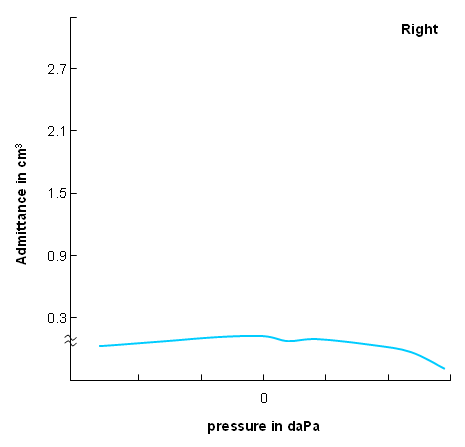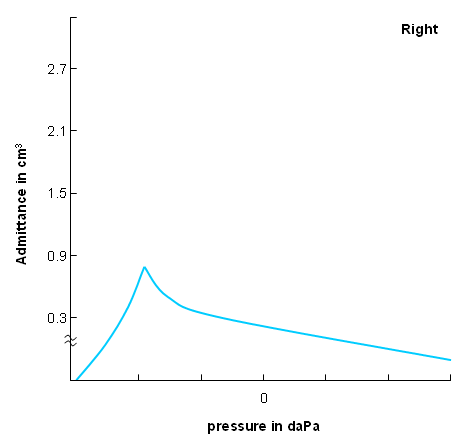Tests
1st tests to order
pneumatic otoscopy
Test
Perform, if available, to assess for the presence of middle ear effusion in a patient with signs and symptoms suggestive of OME.[2] The value of pneumatic otoscopy over standard otoscopy is that it can detect reduced tympanic mobility, which may be the only sign of effusion in a patient with OME.[2]
Pneumatic otoscopy has a sensitivity and specificity of 94% and 80%, respectively, when compared to myringotomy.[54]
Make a diagnosis of OME based on reduced or restricted movement of the tympanic membrane, there doesn’t need to be a complete absence of movement to be diagnostic.[2]
Pneumatic otoscopy might be difficult to perform in young children, in part due to their narrow ear canals and also due to the tendency of young children to move as the investigation is being performed.[55]
Result
decreased movement of tympanic membrane on air insufflation when there is effusion in the middle ear
tympanometry
Test
Perform, if available, in clinic in patients who are difficult to examine and for children in whom the diagnosis is uncertain following pneumatic otoscopy.[2] May also be performed as part of audiologic test battery.
Objectively assesses tympanic membrane mobility, Eustachian tube function, and middle ear function by measuring the amount of sound energy reflected back when a small probe is placed in the ear canal.[2]
[Figure caption and citation for the preceding image starts]: Type B tympanogram; flat compliance curve demonstrates no movement of the tympanic membraneFrom the collection of Erica R. Thaler; used with permission [Citation ends]. [Figure caption and citation for the preceding image starts]: Type C tympanogram, demonstrating a malfunctioning Eustachian tubeFrom the collection of Erica R. Thaler; used with permission [Citation ends].
[Figure caption and citation for the preceding image starts]: Type C tympanogram, demonstrating a malfunctioning Eustachian tubeFrom the collection of Erica R. Thaler; used with permission [Citation ends].
Result
typically a flat (type B) curve (low compliance); a type C curve, which suggests negative pressure, may be seen
audiology
Test
Order in all patients with chronic OME (defined as fluid present in the ear for ≥ 3 months), or for OME of any duration in an at-risk child (see list below), to establish baseline hearing levels and the impact of OME on the patient’s hearing. The test should be appropriate for the patient’s age.[2][1]
Children who have the following conditions are considered to be at risk of developmental sequelae as a result of OME:[53]
Permanent non-OME related hearing loss
Speech and language delay or disorder
Autism-spectrum disorder
Genetic syndromes or craniofacial disorders associated with cognitive or language delays
Blindness or uncorrectable visual impairment
Cleft palate
Developmental delay
Intellectual disability, learning disorders or attention deficit/hyperactivity disorder.
OME can be associated with a variable impact on hearing, from no hearing loss through to a moderate conductive hearing loss.[2]
Tests may include pure tone audiometry (PTA), speech audiometry, and bone-conduction.[1]
The pure tone threshold average at 500, 1000, 2000, and 4000 Hz may show hearing loss, typically of around 28 dB, but can be up to 50 dB in those with OME.[57][58]
Consider any concerns from the parent or carer reporting the hearing loss. Severe hearing loss may indicate pathology other than or in addition to OME, such as congenital sensorineural hearing loss (genetic or nongenetic), inner ear malformations, and ossicular chain abnormalities, and should be appropriately investigated.
Developmental abnormalities or behavioral problems may affect the results of a routine hearing test, in which case referral to an otolaryngologist or audiologist may be required.[2]
Result
may show moderate conductive hearing loss
Tests to consider
nasopharyngeal endoscopy
Test
In patients with chronic or recurrent OME, refer to otolaryngology for consideration of nasal endoscopy to assess for signs of chronic rhinosinusitis, as chronic rhinosinusitis with and without nasal polyposis has been associated with an increased risk of OME.[24][26]
In adults with OME, refer to otolaryngology for consideration of nasopharyngeal endoscopy to assess for nasopharyngeal carcinoma, especially if the effusion is unilateral.[28][24] The rate of nasopharyngeal carcinoma in adults with OME is around 5% to 6%.[28][24]
As a secondary investigation, nasopharyngeal endoscopy may be helpful in children if there is concern about concurrent nasal or adenoidal inflammation or adenoid hyperplasia, if they are tolerant of the exam. Consider this more routinely in areas of high HIV prevalence due to the associated increased risk of nasopharyngeal anomalies, such as lymphoma.[1]
Result
nasopharyngeal mass in adults; nasal/adenoidal inflammation or adenoid hyperplasia in children
Use of this content is subject to our disclaimer